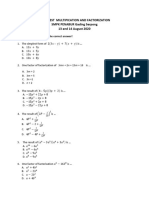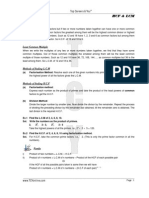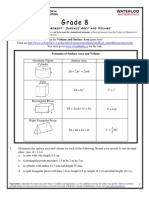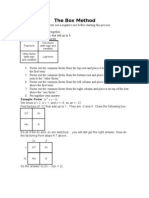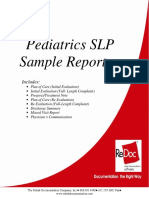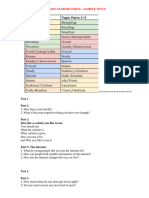0 ratings0% found this document useful (0 votes)
109 Histograms
109 Histograms
Uploaded by
Joel GrayThis document provides instructions and examples for drawing and interpreting histograms using frequency data from tables. It includes 7 practice problems of increasing complexity that involve:
1) Drawing histograms from frequency tables of data about car speeds, tree heights, and apple weights.
2) Calculating estimates from histograms, such as the number of cars traveling over 85 km/h.
3) Finding proportions of data values from a histogram, like the percentage of apples weighing 140-200 grams.
4) Completing partial histograms and frequency tables using data about people's ages.
The goals are to help students learn to accurately draw histograms and extract information from histograms based on frequency data provided in tables.
Copyright:
© All Rights Reserved
Available Formats
Download as PDF, TXT or read online from Scribd
Download as pdf or txt
109 Histograms
109 Histograms
Uploaded by
Joel Gray0 ratings0% found this document useful (0 votes)
This document provides instructions and examples for drawing and interpreting histograms using frequency data from tables. It includes 7 practice problems of increasing complexity that involve:
1) Drawing histograms from frequency tables of data about car speeds, tree heights, and apple weights.
2) Calculating estimates from histograms, such as the number of cars traveling over 85 km/h.
3) Finding proportions of data values from a histogram, like the percentage of apples weighing 140-200 grams.
4) Completing partial histograms and frequency tables using data about people's ages.
The goals are to help students learn to accurately draw histograms and extract information from histograms based on frequency data provided in tables.
Original Description:
Histograms
Original Title
109_histograms
Copyright
© © All Rights Reserved
Available Formats
PDF, TXT or read online from Scribd
Share this document
Did you find this document useful?
Is this content inappropriate?
This document provides instructions and examples for drawing and interpreting histograms using frequency data from tables. It includes 7 practice problems of increasing complexity that involve:
1) Drawing histograms from frequency tables of data about car speeds, tree heights, and apple weights.
2) Calculating estimates from histograms, such as the number of cars traveling over 85 km/h.
3) Finding proportions of data values from a histogram, like the percentage of apples weighing 140-200 grams.
4) Completing partial histograms and frequency tables using data about people's ages.
The goals are to help students learn to accurately draw histograms and extract information from histograms based on frequency data provided in tables.
Copyright:
© All Rights Reserved
Available Formats
Download as PDF, TXT or read online from Scribd
Download as pdf or txt
0 ratings0% found this document useful (0 votes)
109 Histograms
109 Histograms
Uploaded by
Joel GrayThis document provides instructions and examples for drawing and interpreting histograms using frequency data from tables. It includes 7 practice problems of increasing complexity that involve:
1) Drawing histograms from frequency tables of data about car speeds, tree heights, and apple weights.
2) Calculating estimates from histograms, such as the number of cars traveling over 85 km/h.
3) Finding proportions of data values from a histogram, like the percentage of apples weighing 140-200 grams.
4) Completing partial histograms and frequency tables using data about people's ages.
The goals are to help students learn to accurately draw histograms and extract information from histograms based on frequency data provided in tables.
Copyright:
© All Rights Reserved
Available Formats
Download as PDF, TXT or read online from Scribd
Download as pdf or txt
You are on page 1/ 8
Edexcel GCSE
Mathematics (Linear) 1MA0
HISTOGRAMS
Materials required for examination Items included with question papers
Ruler graduated in centimetres and Nil
millimetres, protractor, compasses,
pen, HB pencil, eraser.
Tracing paper may be used.
Instructions
Use black ink or ball-point pen.
Fill in the boxes at the top of this page with your name, centre number and candidate number.
Answer all questions.
Answer the questions in the spaces provided there may be more space than you need.
Calculators may be used.
Information
The marks for each question are shown in brackets use this as a guide as to how much time to
spend on each question.
Questions labelled with an asterisk (*) are ones where the quality of your written communication
will be assessed you should take particular care on these questions with your spelling, punctuation
and grammar, as well as the clarity of expression.
Advice
Read each question carefully before you start to answer it.
Keep an eye on the time.
Try to answer every question.
Check your answers if you have time at the end.
1. The table gives some information about the speeds, in km/h, of 100 cars.
Speed(s km/h) Frequency
60 < s 65 15
65 < s 70 25
70 < s 80 36
80 < s 100 24
(a) On the grid, draw a histogram for the information in the table.
(3)
(b) Work out an estimate for the number of cars with a speed of more than 85 km/h.
..............................................
(2)
(5 marks)
______________________________________________________________________________
2. The table gives information about the heights, h metres, of trees in a wood.
Height (h metres) Frequency
0 < h 2 7
2 < h 4 14
4 < h 8 18
8 < h 16 24
16 < h 20 10
Draw a histogram to show this information.
(3 marks)
______________________________________________________________________________
3. The histogram shows some information about the weights of a sample of apples.
Work out the proportion of apples in the sample with a weight between 140 grams and 200 grams.
..........................................
(4 marks)
___________________________________________________________________________
4. The table shows information about the lengths of time, t minutes, it took some students to do their
maths homework last week.
Time (t minutes) Frequency
0 < t 10 4
10 < t 15 8
15 < t 20 24
20 < t 30 16
30 < t 50 5
Draw a histogram for this information.
(Total 3 marks)
5. The table shows information about the total times that 35 students spent using their mobile phones
one week.
On the grid below, draw a histogram for this information.
(Total for Question 23 = 3 marks)
6. The incomplete table and histogram give some information about the ages of the people who live in a
village.
(a) Use the information in the histogram to complete the frequency table below.
Age (x) in years Frequency
0 < x 10 160
10 < x 25
25 < x 30
30 < x 40 100
40 < x 70 120
(2)
(b) Complete the histogram.
(2)
(Total 4 marks)
______________________________________________________________________________
Frequency
density
0 10 20 30 40 50 60 70
Age in years
7. The table shows the distribution of the ages of passengers travelling on a plane from London
to Belfast.
Age (x years) Frequency
0 < x 20 28
20 < x 35 36
35 < x 45 20
45 < x 65 30
On the grid below, draw a histogram to show this distribution.
(Total 3 marks)
______________________________________________ _____________________________
0 10 20 30 40 50 60 70
Age ( years) x
You might also like
- Gcse Data Work Book Compiled by MR Bradford0% (1)Gcse Data Work Book Compiled by MR Bradford80 pages
- Maths Grade 7 Mathematics 11 15 May 2020 English AREA AND PERIMETER OF 2D SHAPESNo ratings yetMaths Grade 7 Mathematics 11 15 May 2020 English AREA AND PERIMETER OF 2D SHAPES18 pages
- Daily Test Multipication and Factorization SMPK PENABUR Gading Serpong 13 and 14 August 2020No ratings yetDaily Test Multipication and Factorization SMPK PENABUR Gading Serpong 13 and 14 August 20203 pages
- Sine Rule, Cosine Rule and Area Rule - Basics - 1No ratings yetSine Rule, Cosine Rule and Area Rule - Basics - 13 pages
- DP 2 Statistics Test 1-28-01-2021 Time: 50 Min Marks: 40 Answer All Questions On The Lined Paper GivenNo ratings yetDP 2 Statistics Test 1-28-01-2021 Time: 50 Min Marks: 40 Answer All Questions On The Lined Paper Given4 pages
- Histograms Questions Worksheets and Revision MMENo ratings yetHistograms Questions Worksheets and Revision MME1 page
- Topic 24 Further Volume and Surface AreaNo ratings yetTopic 24 Further Volume and Surface Area14 pages
- Old Mutual South African Mathematics OlympiadNo ratings yetOld Mutual South African Mathematics Olympiad16 pages
- Worksheet - Ratio, Averages, PercentagesNo ratings yetWorksheet - Ratio, Averages, Percentages7 pages
- Describing Motion Score: - /30: BPK PENABUR - Physics 8 GradeNo ratings yetDescribing Motion Score: - /30: BPK PENABUR - Physics 8 Grade2 pages
- Atomic Numbers, Protons, Neutrons and Electrons: Name DateNo ratings yetAtomic Numbers, Protons, Neutrons and Electrons: Name Date1 page
- Worksheet 15: Scale Drawings, Bearings and Trigonometry: Answers To Core Revision Exercises: Shape, Space and Measures100% (1)Worksheet 15: Scale Drawings, Bearings and Trigonometry: Answers To Core Revision Exercises: Shape, Space and Measures2 pages
- Conversion of Units of Volume and Capacity: WorkedNo ratings yetConversion of Units of Volume and Capacity: Worked1 page
- Area and Perimeter of Compound Shapes CodebreakerNo ratings yetArea and Perimeter of Compound Shapes Codebreaker2 pages
- Year 7 Autumn 1 Sequences Mini Assessment Answers ANo ratings yetYear 7 Autumn 1 Sequences Mini Assessment Answers A2 pages
- 1 - 10.1 Electricity and Electric Circuits - StudentNo ratings yet1 - 10.1 Electricity and Electric Circuits - Student3 pages
- CBSE Class 10 - Trigonometry Exercise - Mathematics100% (2)CBSE Class 10 - Trigonometry Exercise - Mathematics8 pages
- Factorial, Permutation and Combination: Presented By: Moraga, ShirleyNo ratings yetFactorial, Permutation and Combination: Presented By: Moraga, Shirley26 pages
- Algebra: Simplifying Algebraic Expressions, Expanding Brackets, Solving Linear Equations, Applications. KS3, KS4. Non-Calculator100% (2)Algebra: Simplifying Algebraic Expressions, Expanding Brackets, Solving Linear Equations, Applications. KS3, KS4. Non-Calculator12 pages
- GCSE Maths - Exam Topics - Grade B - Questions - Cumulative Frequency and Box Plots.No ratings yetGCSE Maths - Exam Topics - Grade B - Questions - Cumulative Frequency and Box Plots.12 pages
- Chapter 1-5 Research Paper, Factors Affecting Class Participation of StudentsNo ratings yetChapter 1-5 Research Paper, Factors Affecting Class Participation of Students73 pages
- De Khao Sat Tieng Anh 11 Dau Nam 2024 2025 Truong THPT Le Van Thinh Bac NinhNo ratings yetDe Khao Sat Tieng Anh 11 Dau Nam 2024 2025 Truong THPT Le Van Thinh Bac Ninh7 pages
- 11 0478 2210 13 MS Prov Rma 16102023095614No ratings yet11 0478 2210 13 MS Prov Rma 1610202309561410 pages
- Using A Constant Time Delay Procedure To Teach Foundational Swimming Skills To Children With AutismNo ratings yetUsing A Constant Time Delay Procedure To Teach Foundational Swimming Skills To Children With Autism10 pages
- ESL Reading and Spelling Games Etc UNEDITED90% (10)ESL Reading and Spelling Games Etc UNEDITED80 pages
- Know Your Application Status: (Enter Post Title Here)No ratings yetKnow Your Application Status: (Enter Post Title Here)5 pages
- Maths Grade 7 Mathematics 11 15 May 2020 English AREA AND PERIMETER OF 2D SHAPESMaths Grade 7 Mathematics 11 15 May 2020 English AREA AND PERIMETER OF 2D SHAPES
- Daily Test Multipication and Factorization SMPK PENABUR Gading Serpong 13 and 14 August 2020Daily Test Multipication and Factorization SMPK PENABUR Gading Serpong 13 and 14 August 2020
- DP 2 Statistics Test 1-28-01-2021 Time: 50 Min Marks: 40 Answer All Questions On The Lined Paper GivenDP 2 Statistics Test 1-28-01-2021 Time: 50 Min Marks: 40 Answer All Questions On The Lined Paper Given
- Describing Motion Score: - /30: BPK PENABUR - Physics 8 GradeDescribing Motion Score: - /30: BPK PENABUR - Physics 8 Grade
- Atomic Numbers, Protons, Neutrons and Electrons: Name DateAtomic Numbers, Protons, Neutrons and Electrons: Name Date
- Worksheet 15: Scale Drawings, Bearings and Trigonometry: Answers To Core Revision Exercises: Shape, Space and MeasuresWorksheet 15: Scale Drawings, Bearings and Trigonometry: Answers To Core Revision Exercises: Shape, Space and Measures
- Conversion of Units of Volume and Capacity: WorkedConversion of Units of Volume and Capacity: Worked
- Year 7 Autumn 1 Sequences Mini Assessment Answers AYear 7 Autumn 1 Sequences Mini Assessment Answers A
- 1 - 10.1 Electricity and Electric Circuits - Student1 - 10.1 Electricity and Electric Circuits - Student
- CBSE Class 10 - Trigonometry Exercise - MathematicsCBSE Class 10 - Trigonometry Exercise - Mathematics
- Factorial, Permutation and Combination: Presented By: Moraga, ShirleyFactorial, Permutation and Combination: Presented By: Moraga, Shirley
- Algebra: Simplifying Algebraic Expressions, Expanding Brackets, Solving Linear Equations, Applications. KS3, KS4. Non-CalculatorAlgebra: Simplifying Algebraic Expressions, Expanding Brackets, Solving Linear Equations, Applications. KS3, KS4. Non-Calculator
- GCSE Maths - Exam Topics - Grade B - Questions - Cumulative Frequency and Box Plots.GCSE Maths - Exam Topics - Grade B - Questions - Cumulative Frequency and Box Plots.
- Chapter 1-5 Research Paper, Factors Affecting Class Participation of StudentsChapter 1-5 Research Paper, Factors Affecting Class Participation of Students
- De Khao Sat Tieng Anh 11 Dau Nam 2024 2025 Truong THPT Le Van Thinh Bac NinhDe Khao Sat Tieng Anh 11 Dau Nam 2024 2025 Truong THPT Le Van Thinh Bac Ninh
- Using A Constant Time Delay Procedure To Teach Foundational Swimming Skills To Children With AutismUsing A Constant Time Delay Procedure To Teach Foundational Swimming Skills To Children With Autism
- Know Your Application Status: (Enter Post Title Here)Know Your Application Status: (Enter Post Title Here)









